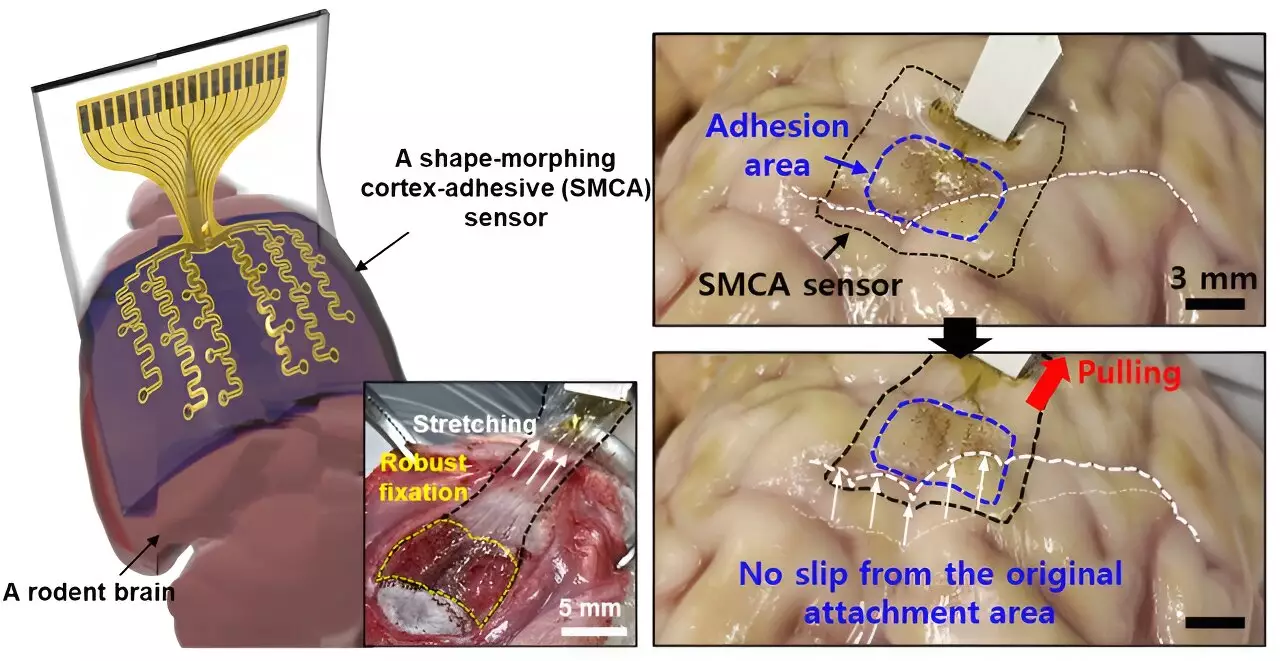The field of neuroscience is on the precipice of a groundbreaking transformation, notably due to recent advancements in transcranial focused ultrasound (tFUS). This non-invasive technique utilizes high-frequency sound waves to stimulate targeted regions in the brain, offering significant hope for treating various neurological disorders. Among these, drug-resistant epilepsy and recurrent tremors stand out as conditions that could greatly benefit from this novel approach.
A collaborative effort from researchers at Sungkyunkwan University (SKKU), the Institute for Basic Science (IBS), and the Korea Institute of Science and Technology has yielded a pivotal development: a revolutionary sensor designed to optimize tFUS therapy. Published in **Nature Electronics**, the paper highlights the sensor’s unique capability to adapt its shape and securely adhere to the complex surface of the brain. This design is crucial, as it enables the simultaneous recording of neural signals and the stimulation of specific brain regions using low-intensity ultrasound waves.
Previous iterations of brain sensors encountered significant challenges due to their inability to conform adequately to the intricate folds of the brain. Donghee Son, the supervising author of the study, recognized these critical limitations. Although earlier designs significantly advanced the precision of brain signal measurements, full adherence remained a key issue, particularly in areas of the brain characterized by severe curvature. The inability to capture precise measurements in these regions often resulted in incomplete analyses and difficulties in diagnosing brain lesions.
The integration of enhanced adhesion technology in the new sensor addresses the shortcomings faced by its predecessors. Notably, the new sensor can maintain a secure attachment to the brain’s surface without creating voids, significantly reducing noise from external movements. This feature is particularly vital for improving the efficacy of tFUS treatments for conditions like epilepsy, wherein accurate monitoring of brain activity is crucial.
Son elaborated on the variability patients experience even within the same neurological condition, complicating the personalization of treatments. Historically, conventional sensors struggled to provide clear readings under the dynamic conditions presented by ultrasound stimulation. However, with a design focused on minimizing interference from mechanical vibrations, the new sensor offers a promising advantage for delivering customized treatments.
The cutting-edge sensor comprises three essential layers: a hydrogel-based layer for chemical and physical bonding to brain tissue, a self-healing polymer that modifies its shape to align with that of the brain, and an ultrathin layer embedded with gold electrodes for effective monitoring. This design ensures that immediately upon application, the hydrogel layer establishes a robust thermodynamic bond with the brain tissue. As this occurs, the self-healing polymer begins molding itself to fit the unique natural curves of the brain, increasing contact area and thus sensor efficacy over time.
Not only does the adaptability of this sensor provide substantial operational advantages, tracking brain signals with unprecedented precision, but it also presents a viable option for long-term studies and treatment strategies—a significant consideration given the dynamics of neurological conditions.
The implications of such advancements transcend epilepsy, with potential applications in diagnosing and treating an even broader array of neurological disorders. Given the sensor’s ability to conform to various brain surfaces seamlessly, researchers anticipate it could also facilitate the mapping of brain activities in other conditions with similar complexities. The adaptability of the sensor indicates potential utility in developing innovative prosthetic technologies, thereby broadening the scope of neurotechnology applications.
Recent testing on awake rodents has yielded promising results, demonstrating the capability to precisely monitor brain waves and control seizures effectively. Moving forward, the research team aims to upscale the technology, culminating in a high-density electrode array through further trials and development.
The future of neurological treatment is brightly lit by innovations in tFUS technology, spearheaded by cutting-edge sensor designs. With ongoing enhancements and clinical validations, this revolutionary approach could significantly alter how conditions like epilepsy are managed, ushering in an era of personalized and precise treatment strategies. As researchers continue to refine this technology, the potential for impactful medical advancements grows, promising new hope for patients affected by complex neurological disorders.
The synthesis of adhesive technology with shape-morphing capabilities in brain sensors encapsulates a major leap forward, emphasizing the growing intersection of neuroscience and engineering in the quest for effective treatments. This combined field may soon yield a new chapter in medical science, where accurate brain function monitoring and treatment are harmoniously aligned, paving the way for transformative patient care.

